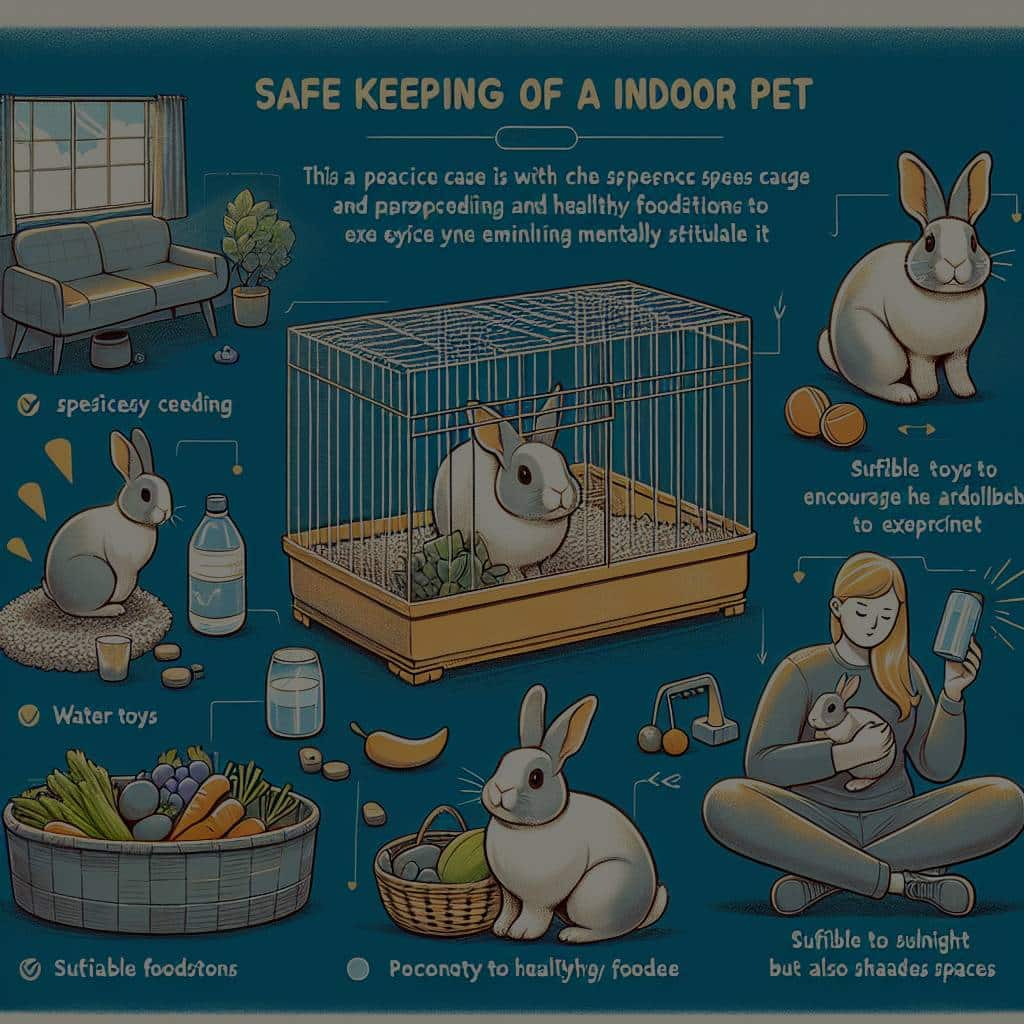As pet lovers, you may find yourselves contemplating different kinds of animals to bring into your homes. One species that has been gaining popularity recently is the rabbit. They are small, adorable and generally low-maintenance, but can you safely keep a rabbit as an indoor pet? The simple answer is yes. However, there are certain requirements and factors that you need to consider to ensure the welfare of these delightful creatures. In this article, we will provide an in-depth view of the necessities and preparations you need to make to keep a rabbit indoors.
1. Creating a Safe and Comfortable Living Space
Before bringing a rabbit home, it is crucial to create a safe and comfortable living space for them. Small as they may be, rabbits need ample room to move around, exercise and play. They are explorative creatures that enjoy hopping around and digging. Hence, an insufficiently spacious area could lead to boredom and restlessness, which could potentially affect their health.
En parallèle : What’s the Best Way to Keep Your Pet’s Food and Water Bowls Clean and Sanitary?
You may consider a hutch as a primary enclosure for your bunny. It should be large enough for your rabbit to stand on their hind legs without their ears touching the top. Moreover, it should allow them enough room to make at least three hops from one end to the other.
Aside from the hutch, it’s advisable to allocate a safe and secure area within the house where the rabbit can roam and exercise freely. This area should be rabbit-proofed, meaning it should be devoid of any dangerous objects and substances that can harm the rabbit, such as electrical wires, toxic plants, and harmful household chemicals.
Avez-vous vu cela : What’s the Ideal Exercise Routine for a Dog with Hip Dysplasia?
2. The Importance of a Proper Diet
Rabbits have specific dietary needs that you need to meet to keep them healthy and happy. Their diet primarily consists of hay, vegetables, water, and a small amount of pellets.
Hay plays a significant role in a rabbit’s diet as it aids in digestion and dental health. It should make up about 70% of a rabbit’s diet. Let your bunny have unlimited access to hay at all times.
Fresh vegetables are also crucial for a rabbit’s health, providing them with necessary vitamins and nutrients. Remember to introduce new vegetables gradually to avoid upsetting their sensitive digestive system.
Despite their popularity in pet shops, pellets should only make up a small portion of a rabbit’s diet. They are not a substitute for hay or vegetables but can supplement their diet.
It’s also important to leave a bowl of fresh, clean water for your rabbit at all times to keep them hydrated.
3. Litter Training Your Rabbit
Yes, you read that right. Rabbits can be litter-trained, which makes it easier to keep them indoors. This is because rabbits are naturally clean animals and would prefer to do their business in one spot. The key to successful litter training is patience and consistency.
Start by placing a litter box inside their hutch or enclosure that’s filled with a paper-based litter. Avoid clumping or cat litters as they can cause health issues if ingested. It’s also a good idea to put some hay in the litter box since rabbits often like to nibble while they’re doing their business.
4. Exercise and Enrichment for Indoor Rabbits
Just like other pets, rabbits need to exercise to stay healthy. An indoor rabbit needs at least three to four hours of exercise outside their hutch each day. This is where your rabbit-proofed zone comes into play.
Enrichment is also a crucial aspect of a rabbit’s care. This means providing them with toys, tunnels, and safe items to chew to keep them mentally stimulated. Rabbits love to chew, so provide them with plenty of chew toys to prevent them from gnawing on your furniture.
5. Regular Health Checks
Lastly, regular health checks are crucial in maintaining your rabbit’s well-being. This entails monitoring their eating, drinking, and litter habits, as any changes could indicate a problem. Make sure to have a trusted vet who is well-versed in rabbit care to consult when you suspect something is amiss.
Furthermore, grooming your rabbit regularly can also help you keep track of any changes in their skin, fur, teeth, or nails. This is especially true for long-haired breeds that need frequent grooming to prevent matting and other fur-related issues.
In conclusion, while keeping rabbits indoors requires commitment and effort, the rewards far outweigh the challenges. The only requirement is your willingness to learn and provide what your adorable bunny needs to thrive and enjoy life within your home.
6. Socialization and Handling of Indoor Rabbits
Rabbits are social creatures, and as such, thrive in environments where they can interact with others. It’s essential to spend time with your pet rabbit daily, be it through playing or just sitting with them. If you can’t devote enough time to your rabbit, it is advisable to consider having two rabbits instead. They can offer each other companionship, but ensure they are spayed or neutered to avoid unexpected bunnies.
Handling your rabbit appropriately is also a vital part of their well-being. Rabbits are prey animals, and so, they might feel threatened if handled incorrectly. Hold your rabbit gently but firmly, ensuring their feet are supported at all times. Never pick up a rabbit by their ears or scruff, and avoid turning them onto their backs.
Children should always be supervised when handling rabbits due to their delicate skeletal structure. It’s crucial to teach them to respect the rabbit’s space and to interact with them gently.
7. Understanding Rabbit Behaviour
Understanding rabbit behavior is key to ensuring a healthy and comfortable life for your indoor rabbit.
Rabbits have a unique way of communicating their feelings – it’s done through a variety of bunny body languages. A happy rabbit may show signs of joy by performing “binkies” – a joyful leap in the air. If a rabbit thumps their hind leg, it usually indicates fear or warning. A rabbit that is grinding its teeth loudly could be in pain and needs immediate vet attention.
Also, it’s essential to know that rabbits are crepuscular, which means they are most active during dawn and dusk. So, don’t be surprised if your pet rabbit seems uncharacteristically energetic early in the morning or late in the evening.
Conclusion
Keeping house rabbits can indeed be a rewarding experience. With the right care and attention, indoor rabbits can live a long, happy, and healthy life. Regularly checking their litter tray, offering a balanced diet, providing enough exercise area, and giving lots of love are all part of successful rabbit care. Remember, every rabbit will have its own personality and quirks which will make the whole experience even more special.
It’s important to remember that owning any pet is a commitment and rabbits are no exception. They require as much attention and care as any other pet. But if provided with all the necessary care, rabbits will surely make a fun, charming, and loving addition to your family.











